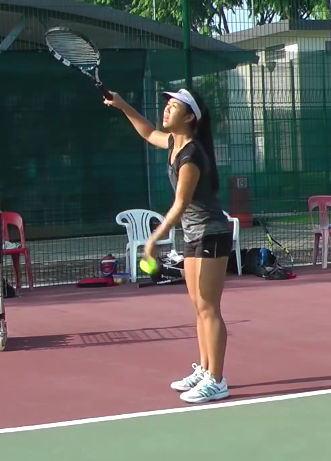I've had a look at some of of your other contributions on these boards regarding ISR. Very interesting stuff and Thank You.
My suggestion was based on a technique that we used succesfully to transition a junior player to a decent serve. He originally had a very poor throwing action. Initially worked on it using a tennis ball. Then moved to a junior tennis racquet to get a feel for the throw with something other than a tennis ball. Then moved to his normal tennis racquet and started serving tennis balls. Worked very wel for him.
I can't know the results of progressions except by what is said. Glad to hear about your positive experience and some others.
I often examine progressions in videos to see if they appear to simulate the high level tennis serve in some parts. Very often they don't, so I'm skeptical about how progressions simulate the serve biomechanics.
For example, here is a frame from a 'Throw the Racket' instructional video.
1) The server has a Waiter's Tray racket face orientation - facing the sky.
2) She shows no evidence of ISR.
3) The orientation between her shoulder and upper arm is too high bringing up issues of risk of impingement if she were doing ISR.
What do most people do when asked to throw a racket?
I'd say that this progression does not simulate the serve and that the upper arm orientation to the shoulder joint is not correct for a high level serve. It would add to the risk of shoulder impingement for a high level serve. For this unknown technique, is there added impingement risk?
Here is Pat Dougherty's video on the upward throw as a progression for teaching the service motion.
Stop action on Youtube - use the "
." key and the "
," key. Look at the double exposure showing the arm for the throw and the serve.
Throw with double exposure of forearm and ball showing motion
Serve with double exposure of forearm and racket showing motion.
These two frames show that the upper arm is being used in a very similar way for the upward throw and the tennis serve. [Upper arm is the humerus bone between the shoulder joint and elbow joint.]
The elbow is bent for the throw so that ISR provides hand speed. (Exact time of release not available in this slow video). For the serve the elbow has hardly any bend and the racket is held at an angle to provide racket head speed from internal shoulder rotation.
Read more:
http://asmiforum.proboards.com/thre...overhead-baseball-tennis?page=1#ixzz5IKTUsPLl
Take a racket in your hand and try ISR. Change the angle between the forearm and racket with your wrist together with ISR arm rotation.
In my opinion, Pat Dougherty's video looks like an excellent way to apply a throwing progression for the serve. Even the body tilt and the angle of the upper arm is similar as the two frames show.
Note - both the serve and throw use stretched muscles for the motion.It is not simply going to positions.
When it comes to throwing the racket I can see that would be useful to exercise the elbow extension that is part of the serve as the arm becomes near straight. But I don't see the ISR as being used. One reader understood that point and experimented in trying to throw a racket with ISR. He said that it was difficult mainly in controlling when to release the racket.




